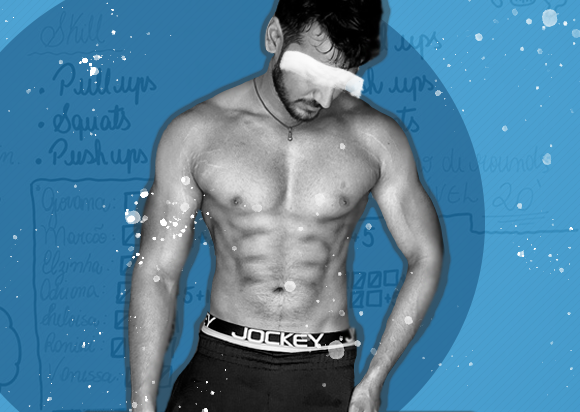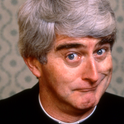
The central character of Alan Hollinghurst’s most recent book, The Sparsholt Affair, is first seen lifting weights. The year is 1940, and weightlifting is seen as something fantastical and alluring: glimpsed in a window across an Oxford quad, “the source of the shadow moved slowly into view, a figure in a gleaming singlet, steadily lifting and lowering a pair of hand-weights.” David Sparsholt immediately provokes a collective passion among the homosexuals on campus—but he is also described in the opening chapter as “the exhibitionist” and “this ridiculous fellow.” It’s one of the book’s many consummate ironies that something now so mundane and ubiquitous as working out should both be synonymous with Sparsholt’s sexual ambiguity, and tell us a great deal about his vanity and self-possession.
In 1940 the silver screen sex symbols of the day would have been Cary Grant, Gregory Peck, Clark Gable, even John Wayne. You only have to google “Clark Gable shirtless” to find a perfectly pleasant result, but one that in today’s lexicon would be called ‘dadbod.’ Peck, likewise, is nicely built, but you would struggle to find anything that could pass for definition on his body.
At the time, Charles Atlas, the bodybuilder who marketed his exercise regime to America, would have been at the height of his fame. Still, though, the body ideal he represented has something rather quaint to it: big arms, a solid torso, slightly wobbly on the abs, and clearly not many leg days in his past. This is generally the sort of body that Burt Lancaster would rock in films such as The Crimson Pirate (1952), and he was marketed very much as a buff body-man; a muscular so-and-so who had training as an acrobat. Looking at photos of Lancaster now, cavorting on a beach with Ava Gardner, he has the appearance of one of your more handsome, carefree pals in an un-posed Instagram snap—all lithe limbs and quiet horsepower.
Burt Lancaster appears shirtless.
How did we get from there to the current fashion for highly built male bodies—and have we gone so far now in the cult of the hench that we can only move back to an alternative body ideal? (The question of female bodies, where exercise is connected much more to the thinness ideal and to questions of ‘health’ rather than strength, may be for another essay.) Over the last ten to fifteen years, bodies seem to have reached such a peak of buffness, promoting a male image that borders on the unreal—think Chris Hemsworth in Thor, or Michael B. Jordan in Creed.
Muscled bodies have been around for a while of course—but in the 80s and 90s, the muscled bodies of Sylvester Stallone and Arnold Schwarzenegger were seen not as an attractive ideal to be desired and replicated, but almost as something embarrassing (hangers-on like Jean-Claude Van Damme and Steven Seagal probably didn’t help matters). The fancied guys of the time—your Christian Slaters and Ethan Hawkes—tended to keep their jumpers on or look somewhat lanky.
This presents a stark contrast with our time, when there seems to be a sense that the shredded body can be replicated by all and sundry. In our time, a heavily worked-at body is held up as desirable, and even attainable, possibly against the weight of science and evidence. The rise of this body type may be due to several factors: the rise of social media as a way of framing and promoting a certain body image; heavily marketed and relatively cheap gyms; the ubiquity of superhero franchises; and even the advent of high-definition televisions along with reality TV and cable sports. What’s clear is that a ripped body has now become almost a prerequisite for a certain type of fame. When Parks and Recreation star Chris Pratt landed the lead role in Guardians of the Galaxy, he was required not only to lose weight but build a six-pack—an asset which is also obligatory for male contestants of the hit reality TV show Love Island.
What’s more, celebrities increasingly encourage mimicry of their bodies, with varying degrees of consciousness—whether via social media or other means. In 2013 Joe Manganiello, one of the hunks from Magic Mike XXL, released Evolution: The Cutting Edge Guide to Breaking Down Mental Walls and Building the Body You've Always Wanted—a book which advocates a hilariously unrealistic regimen. In a comically hardcore excerpt I got my hands on, Manganiello suggested that exercisers should be left shaking by their daily workout to the point that they couldn’t get their keys in the car door. The actor Rob McElhenney mocked this line of thinking with a post on Instagram earlier this year after he had got torn for the purpose of an episode of It’s Always Sunny In Philadelphia, writing, “Look, it’s not that hard. All you need to do is lift weights six days a week, stop drinking alcohol, don’t eat anything after 7pm, don’t eat any carbs or sugar at all, in fact just don’t eat anything you like, get the personal trainer from Magic Mike, sleep nine hours a night, run three miles a day, and have a studio pay for the whole thing over a six to seven month span. I don’t know why everyone’s not doing this. It’s a super realistic lifestyle and an appropriate body image to compare oneself to.”

So many more questions remain, not least about the adverse effects of a hyper-muscled body ideal, such as rising eating disorders among young men. In 2015 the government’s mental health tsar, Natasha Devon, called for a minimum age of 16 to be enforced for gym memberships, citing the dangers of steroid use, over-built bodies, and distorted body image as her chief concerns.
But some believe the tide is slowly turning. Kayleigh Donaldson, a writer for Pajiba and Screen Rant, said: “Look at Chris Hemsworth over the course of his Thor run. He's noticeably leaner in Ragnarok and better for it. I think the studios are worried the logistics of such workouts will get out of hand.” And there are signs that some in the new generation may not be as hung up on the rippling pecs aesthetic—surely, in part, because it can rub up against a new understanding of body positivity, but also runs somewhat counter to a new image of masculinity as advocated by young actors like Lucas Hedges, who appears not to be all about the power and manliness thing. This time last year, the actor Asa Butterfield tweeted, “Well now I’ve got a gym membership, wish me luck…” and, two months later, “I’m really not about this gym life.”
"I think the studios are worried the logistics of such workouts will get out of hand."
Then again, body standards seem to be propagating this aesthetic still. The average screenview on gay men’s dating app Grindr is filled with headless buff torsos. The gay community’s body standards—and racism—are such that the dating app recently implemented an initiative to encourage men to be kinder to each other. Still a body-negative discourse endures in user bios, which speak in barely-coded terms of staying “healthy” or “gym-fit” when they don’t discriminate openly against fat people. The key difference between public or famous muscly bodies now, and strong bodies of old, does seem to lie in the way we now seek to replicate, or at least adapt, certain standards from our screens to our own lives.
Perhaps an answer to the question of where body-shapes go next lies in taking a different approach to gender. A constant in superhero films is bodies and gender roles being delineated along a strict binary, with men adopting positions of noble responsibility. How long this can continue is anyone’s guess.












